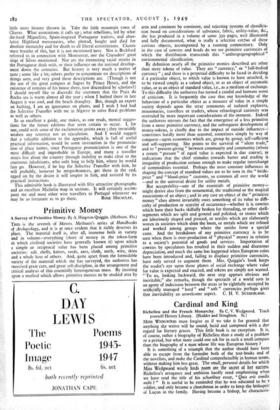Primitive Money
A Survey of Primitive Money. By A. Hingston Quiggin. (Methuen. 45s.)
THIS is the seventh of Messrs. Methuen's series of Handbooks oi Archaeology, and it is at once evident that it richly deserves its place. The material itself is, after all, immense both in variety and in volume—everything (short of money in the token-form in which civilised societies have generally known it) upon which a simple or reciprocal value has been placed among primitive societies: salt, shells, knives, seeds, axes, cloth, teeth, wire, skins and a whole host of others. And, quite apart from the formidable variety of the material which she has surveyed, the authoress has exercised great care, and great self-discipline, in the arrangement and critical analysis of this essentially heterogeneous mass. By insisting upon a method which allows primitive monies to be studied area by
area and continent by continent, and rejecting systems of classifica- tion based on considerations of substance, fabric, utility-value, &c., she has produced in a volume of some 35o pages, well illustrated and fully documented, what is really a selective corpus of these curious objects, accompanied by a running commentary. Only in the case of cowries and beads do we see primitive currencies of which the distribution transcends this " anthropogeographical " environmental classification.
By definition nearly all the primitive monies described are other than mere tokens of value. They are " currency," or " full-bodied currency " ; and there is a perpetual difficulty to be faced in deciding if a particular object, to which value is known to have attached, is to be viewed simply as a valued object, or as an object of automatic value, or as an object of standard value, i.e., as a medium of exchange. To this difficulty the authoress has turned a candid and humane sense of criticism. It is frequently the case that our knowledge of the behaviour of a particular object as a measure of value in a simple society depends upon the stray comments of isolated explorers, missionaries, travellers or traders, whose ethnological curiosity was overruled by more important considerations of the moment. Indeed the authoress stresses the fact that the emergence of a less primitive from a more primitive currency, and the subsequent development of money-tokens, is chiefly due to the impact of outside influences— sometimes hardly more than seasonal, sometimes simply by way of conquest—upon economies which are, group by group, self-sufficient and self-supporting. She points to the survival of " silent trade," and to " present-giving " between community and community (where a return " present " of equal value is expected in due course), as indications that the chief stimulus towards barter and trading is inequality of production serious enough to make regular interchange of commodities essential. Perhaps the most constant influences in shaping the concept of standard values are to be seen in the " bride- price " and " blood-price " customs, so common all over the world —and in the universal desire for utility metals.
But acceptability—one of the essentials of primitive money— might derive also from the ornamental, the traditional or the magical associations of an object ; and in any case an object of the " primitive money " class almost invariably owes something of its value to diffi- culty of production or scarcity of occurrence—whether it is cowries which have their backs skilfully broken for threading, or other shell- segments which arc split and ground and polished, or stones which are laboriously shaped and pierced, or textiles which are elaborately woven in societies which shun the loom, or metals which are refined and worked among groups where the smiths form a special caste. And the breakdown of any primitive currency is to be seen when there is over-production of " physical " money in relation to a society's potential of goods and services. Importation of cowries by speculators has resulted in their sudden and disastrous depreciation, and much the same has happened when European coins have been introduced and, failing to displace primitive currencies, have only served to augment them. Mrs. Quiggin's book keeps the reader's eye upon those planes of social exchange where value for value is expected and exacted, and tokens arc simply not wanted. "To us, looking backward, the next step appears obvious and inevitable," she remarks, though the spectacle of a world torn in an agony of indecision between the areas to be rightfully occupied by artificially managed " hard " and " soft " currencies perhaps gives that inevitability an unwelcome aspect. C. H. V. SUTHERLAND.


































 Previous page
Previous page